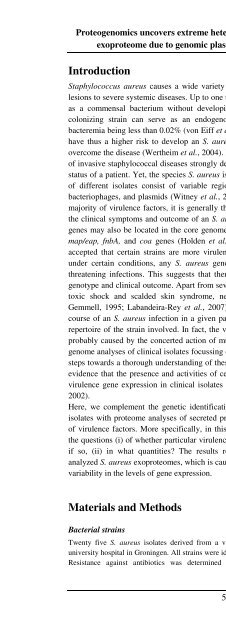The Staphylococcus aureus secretome - TI Pharma
The Staphylococcus aureus secretome - TI Pharma
The Staphylococcus aureus secretome - TI Pharma
You also want an ePaper? Increase the reach of your titles
YUMPU automatically turns print PDFs into web optimized ePapers that Google loves.
Proteogenomics uncovers extreme heterogeneity in the <strong>Staphylococcus</strong> <strong>aureus</strong><br />
exoproteome due to genomic plasticity and variant gene regulation<br />
Introduction<br />
<strong>Staphylococcus</strong> <strong>aureus</strong> causes a wide variety of human infections ranging from superficial<br />
lesions to severe systemic diseases. Up to one third of the human population carries S. <strong>aureus</strong><br />
as a commensal bacterium without developing any clinical symptoms. Nevertheless, the<br />
colonizing strain can serve as an endogenous reservoir for infection, the incidence of<br />
bacteremia being less than 0.02% (von Eiff et al., 2001). Individuals colonized with S. <strong>aureus</strong><br />
have thus a higher risk to develop an S. <strong>aureus</strong> infection, but they are also more likely to<br />
overcome the disease (Wertheim et al., 2004). It is undisputed that the incidence and outcome<br />
of invasive staphylococcal diseases strongly depend on host factors, in particular the immune<br />
status of a patient. Yet, the species S. <strong>aureus</strong> is highly diverse and up to 30% of the genomes<br />
of different isolates consist of variable regions, such as pathogenicity islands, lysogenic<br />
bacteriophages, and plasmids (Witney et al., 2005). Since these genetic elements encode the<br />
majority of virulence factors, it is generally thought that their presence critically determines<br />
the clinical symptoms and outcome of an S. <strong>aureus</strong> infection. However, virulence-associated<br />
genes may also be located in the core genome as illustrated by the spa, aur, hla, lip, clfAB,<br />
map/eap, fnbA, and coa genes (Holden et al., 2004; Peacock et al., 2002). It is generally<br />
accepted that certain strains are more virulent than others (Melles et al., 2004), although,<br />
under certain conditions, any S. <strong>aureus</strong> genotype may have the potential to induce lifethreatening<br />
infections. This suggests that there is no simple relationship between bacterial<br />
genotype and clinical outcome. Apart from several well-defined toxin-mediated diseases (e.g.<br />
toxic shock and scalded skin syndrome, necrotizing pneumonia) (Musser et al., 1990;<br />
Gemmell, 1995; Labandeira-Rey et al., 2007), it remains difficult to predict the onset and<br />
course of an S. <strong>aureus</strong> infection in a given patient solely on the basis of the virulence gene<br />
repertoire of the strain involved. In fact, the vast majority of severe S. <strong>aureus</strong> infections are<br />
probably caused by the concerted action of multiple virulence factors. Molecular typing and<br />
genome analyses of clinical isolates focussing on virulence gene distribution have been major<br />
steps towards a thorough understanding of these complex phenomena. Also, there is growing<br />
evidence that the presence and activities of certain regulators play a role in the variation of<br />
virulence gene expression in clinical isolates (Blevins et al., 2002; Karlsson and Arvidson,<br />
2002).<br />
Here, we complement the genetic identification of virulence factors in different S. <strong>aureus</strong><br />
isolates with proteome analyses of secreted proteins, which represent an important reservoir<br />
of virulence factors. More specifically, in this proteogenomics approach we have addressed<br />
the questions (i) of whether particular virulence genes are expressed in different isolates and,<br />
if so, (ii) in what quantities? <strong>The</strong> results reveal an unprecedented heterogeneity in the<br />
analyzed S. <strong>aureus</strong> exoproteomes, which is caused by both genomic plasticity and an amazing<br />
variability in the levels of gene expression.<br />
Materials and Methods<br />
Bacterial strains<br />
Twenty five S. <strong>aureus</strong> isolates derived from a variety of human infections were collected by the<br />
university hospital in Groningen. All strains were identified as S. <strong>aureus</strong> by plating and coagulase tests.<br />
Resistance against antibiotics was determined by routine disk diffusion assays. For RNAIII<br />
55













